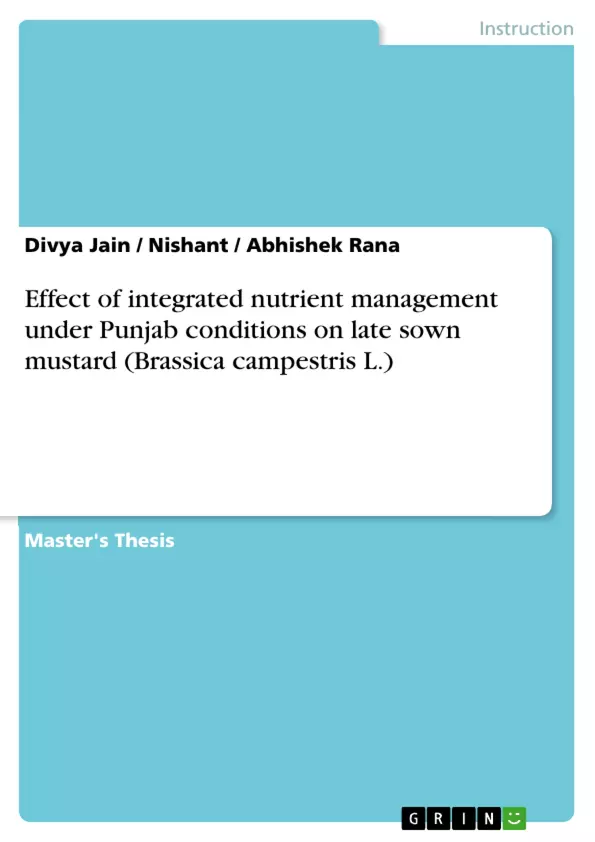The present investigation entitled “Effect of integrated nutrient management on late sown mustard under punjab conditions (Brassica campestris L.)” was conducted during rabi season of 2018-19 with the objective to find out the impact of integrated nutrient management on growth, yield, nutrient content, nutrient uptake and economics of Mustard. The soil of experimental field was clay loam texture, alkaline in nature with pH (7.91), EC is (0.59) and available nitrogen (205.5) kg ha-1, available phosphors (12.7 kg ha-1), available potassium (231.5 kg ha-1), available sulphur (7.50 kg ha-1), available zinc (0.94) and boron (0.72 mg kg-1).
The experimental results revealed that significantly maximum growth parameters (plant height, branches plant-1, dry matter accumulation, and leaf area index), yield attributes (siliqua length, siliquae plant-1, seeds siliqua-1and test weight), yield (grain and stover), nutrient uptake(N, P, K, S, Zn and B) by grain and stover and available soil nutrient (N, P, K, S, Zn, and B), were noticed under the application of 100% NPK+40 kg S+1.5 B+20 kg Zn ha-1 as compared to rest of the treatments.
The increment in seed yield under application of 100% NPK+40 kg S+1.5 B+20 kg Zn ha-1 was 25.32 % over 100% NPK. Likewise, maximum gross return, net return and B:C ratio were also recorded with the application of 100% NPK+40 kg S+1.5 B+20 kg Zn ha-1. Besides, this combination also improves the quality of produce and physico-chemical properties of soil. The results revealed that among nutrient management practices, the application of 75% RDF + FYM 10t ha-1 being at par with 75% RDF + vermicompost 5t ha-1 recorded maximum growth and yield attributes, grain (24.14 and 21.74 q ha-1, respectively), strover (81.75 and 75.24 q ha-1, respectively) & biological yield (104.82 and 99.44 q ha-1, respectively), nutrient content and NPK uptake of mustard. In contrast, the application 75% RDF + FYM 10t ha-1 exhibited maximum net return (43228.5 ₹ ha-1) and B: C (1.05) of mustard.
Inhaltsverzeichnis (Table of Contents)
- Introduction
- Aims and objectives
- Review of Literature
- Effect of integrated nutrient management on growth parameters of mustard
- Effect on Grain and straw yield& yield attributing characters of mustard
- Nutrient content and their uptake
- Effect on Economics
- Materials and Methods
- Experimental site
- Climate and weather conditions
- Soil of the experimental field
- Cropping history of the experimental field
- Experimental details
- Treatments
- Treatments Details
- Layout plan
- Description of variety under investigation:
- Cultural operations
- Field preparations
- Manures and Fertilizer application
- Seeds and sowing
- Water application
- Hand weeding
- Harvesting
- Threshing
- Observations recorded
- Growth characters
- Plant height
- Number of branch
- Dry matter accumulation
- Leaf area index (LAI)
- Yield and yield attributes
- Length of siliqua
- Number of siliquae plants-1
- Number of seeds siliquae-1
- Test weight (1000-seed weight)
- Seed yield (q ha-1).
- Stover yield (q ha-1)
- Biological yield (q ha-1)
- Chemical studies
- Plant Analysis
- Nitrogen
- Digestion for P and K sample
- Colour develop for P
- Potassium
- Protein content
- Oil content
- Soil analysis
- Collection of soil samples
- Available soil N
- Available soil P
- Available soil K
- Available soil S
- Available soil Zn
- Available soil B
- pH Measurement
- Electrical conductivity (EC)
- Organic carbon (OC)
- Bulk density (BD)
- Economic studies
- Cost of cultivation (₹ ha-1)
- Gross return (₹ ha-1)
- Net returns (₹ ha-1)
- Benefit cost ratio (B:C)
- Statistical Analysis
- Standard error of mean
- Critical Difference
- Analysis of Variance (ANOVA)
- Results
- Discussion
- Summary
- Conclusion
- References
- Appendix – I
- Appendix – II
- Appendix – III
Zielsetzung und Themenschwerpunkte (Objectives and Key Themes)
This study aimed to investigate the effect of integrated nutrient management on the growth, yield, and quality of late-sown mustard (Brassica campestris L.) under Punjab conditions. The research sought to understand the impact of various nutrient combinations on key growth parameters, yield components, nutrient uptake, and economic feasibility.
- Impact of Integrated Nutrient Management on Mustard Growth and Development
- Influence of Nutrient Management on Yield and Yield Attributes
- Nutrient Content and Uptake by Mustard Plants
- Economic Evaluation of Different Nutrient Management Strategies
- Effect of Nutrient Management on Soil Fertility
Zusammenfassung der Kapitel (Chapter Summaries)
The "Introduction" chapter provides background information on the significance of rapeseed-mustard production in India, highlighting its economic importance, global production trends, and the challenges associated with late sowing. The "Aims and objectives" section outlines the specific goals of the study, focusing on the impact of integrated nutrient management on mustard growth, yield attributes, nutrient uptake, and economic feasibility. The "Review of literature" chapter presents a comprehensive overview of existing research on the effects of different nutrient management practices on various aspects of mustard growth and yield, including growth parameters, yield attributing characters, nutrient content, and economics. The "Materials and Methods" chapter provides detailed information on the experimental setup, including the experimental site, climate and weather conditions, soil characteristics, cropping history, treatments, layout plan, variety description, cultural operations, observations recorded, chemical studies, soil analysis, and statistical analysis.
Schlüsselwörter (Keywords)
The main keywords and focus topics of the text include integrated nutrient management, late-sown mustard, Brassica campestris L., Punjab conditions, growth parameters, yield attributes, nutrient uptake, economic feasibility, soil fertility, nitrogen, phosphorus, potassium, sulphur, zinc, boron.
- Quote paper
- Ph.D. (Pursuing) Divya Jain (Author), Dr. Nishant (Author), Abhishek Rana (Author), 2020, Effect of integrated nutrient management under Punjab conditions on late sown mustard (Brassica campestris L.), Munich, GRIN Verlag, https://www.grin.com/document/1031483



